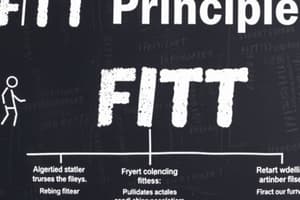Podcast
Questions and Answers
What is the primary purpose of 'Cheer' in cheerdance?
What is the primary purpose of 'Cheer' in cheerdance?
- Expressive physical movements
- Motivational shouts for teams (correct)
- Creating rhythmic dance patterns
- Performing intricate stunts
Who is recognized as the first cheerleader?
Who is recognized as the first cheerleader?
- Annie H. Smith
- Thomas A. Nelson
- Johnny Campbell (correct)
- Henry McDonald
Which of the following is NOT a major competition for cheerdance in the Philippines?
Which of the following is NOT a major competition for cheerdance in the Philippines?
- NCC
- NCAA
- PBA (correct)
- UAAP
Which type of jump involves arms up and legs apart?
Which type of jump involves arms up and legs apart?
What is the primary focus of tumbling in cheerdance?
What is the primary focus of tumbling in cheerdance?
What is the recommended frequency for cardio exercise according to the FITT principle?
What is the recommended frequency for cardio exercise according to the FITT principle?
Which of the following is NOT an element of dance?
Which of the following is NOT an element of dance?
What is a key health benefit of regular exercise?
What is a key health benefit of regular exercise?
Which type of exercises fall under the category of strength training?
Which type of exercises fall under the category of strength training?
Which of the following is a barrier to physical activity?
Which of the following is a barrier to physical activity?
Why is recovery important between strength training sessions?
Why is recovery important between strength training sessions?
What is the primary focus of cardio exercise in terms of fitness goals?
What is the primary focus of cardio exercise in terms of fitness goals?
How does intensity adjustment occur as one’s fitness improves?
How does intensity adjustment occur as one’s fitness improves?
Flashcards are hidden until you start studying
Study Notes
FITT Principles or Formula
- Frequency refers to how often exercise is performed; guidelines suggest 5-6 times per week for cardio and 2-3 times per week for strength training.
- Intensity is the effort level during exercise; varies for cardio (easy to moderate) and strength (based on weight and sets/reps).
- Time indicates the duration of exercise; cardio sessions should last 30-60 minutes or longer, while strength time varies by workout intensity.
- Type refers to the nature of exercise; recommended forms include continuous cardio activities like running and cycling, and strength exercises utilizing free weights or body weight.
FITT Application
- Used as a guide for cardiovascular fitness and weight loss training.
- Exercise must be controlled to manage stress levels and prevent injuries.
- Regular physical activity enhances overall fitness and health outcomes.
- Monitoring through FITT assists in evaluating the success of an exercise program.
Nature of Dance and Elements of Dance
- Dance is defined as rhythmic movements to music that convey ideas or emotions, acting as an expressive art form.
- Key elements of dance include:
- Body: The movement vocabulary and expression of emotions.
- Energy: The intensity of movements, ranging from gentle to forceful.
- Space/Level: Utilizing the surrounding environment creatively.
- Relationship: The interactions and communication occurring through dance.
- Timing: Syncing movements with musical rhythms.
Categories of Movements
- Locomotor Movements: Transitioning from one location to another, such as walking or running.
- Non-locomotor Movements: Stability and balance activities, including twisting or balancing.
- Manipulative Skills: Control over objects through activities like dribbling and catching.
Barriers to Physical Activity
- Common hindrances include:
- Lack of time or social support, low energy, and motivation.
- Concerns about injury and insufficient skill levels.
- High costs, lack of facilities, and adverse weather conditions.
Cheerdance
- Cheerdance combines cheerleading (motivational shouts) and dance (expressive physical movement).
- Originated on November 2, 1898, credited to Johnny Campbell, the first cheerleader known for rallying crowds.
- Major competitions in the Philippines include UAAP, NCAA, and NCC.
Types of Jumps in Cheerdance
- High “V” Jump: Arms raised, legs apart.
- Spread Eagle: Knees drawn to the chest, arms in “T” or “V” position.
- Tuck Jump: Legs straddled, arms in “T,” with knees elevated.
Stunts and Tumbling
- Flyers (often female) are lifted by bases (typically male), emphasizing safety in all stunt executions.
- Types of tumbling that enhance routines include:
- Standing tumble: Performed from a stationary position.
- Running tumble: Initiated from a run.
- Cartwheel: Revolves sideways like a wheel.
Basic Formations in Cheerdance
- Common formations include:
- Bowling Pin
- Diamond
- Diagonal
- Staggered
Studying That Suits You
Use AI to generate personalized quizzes and flashcards to suit your learning preferences.




